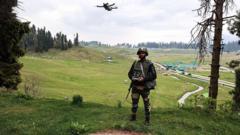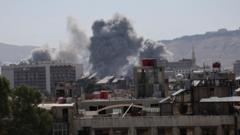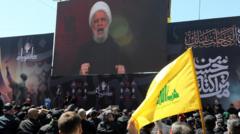The first instances of drone warfare in the India-Pakistan rivalry have erupted, with allegations of strikes exchanged between both nations. Experts warn the use of unmanned systems could evolve into a critical and destabilizing component of a traditional military standoff as both sides bolster their aerial arsenals.
Escalation of Unmanned Warfare: India-Pakistan Tensions Intensify

Escalation of Unmanned Warfare: India-Pakistan Tensions Intensify
Recent drone strikes between India and Pakistan signify a dangerous evolution in their long-standing conflict, raising fears of heightened military engagement.
The first instance of drones being employed in active warfare between the nuclear-capable neighbors, India and Pakistan, has unfolded amidst escalating tensions in the South Asian region. On Thursday, Indian officials accused Pakistan of deploying drone and missile attacks against Indian military installations in Jammu and Kashmir, a claim that was firmly denied by Islamabad. In retaliation, Pakistan asserted that it successfully brought down 25 Indian drones across multiple significant cities, including Karachi and Lahore, without receiving a comment from India.
As international communities call for restraint, experts express that these exchanges represent a pivotal moment within the enduring rivalry, with unmanned combat now roofing the familiar clash of artillery. "We’re witnessing the beginning of a new era in the India-Pakistan conflict—an age in which drone technology and unmanned systems may redefine the players' strategic calculus," highlighted Jahara Matisek, a distinguished professor at the US Naval War College.
Since Wednesday, counter-conflict reports indicate heavy casualties on both sides, with Pakistan's army citing 36 fatalities and injuries to 57 from India's activities, while Indian authorities recount at least 16 civilian fatalities due to Pakistani shelling. India's action was espoused as a reprisal for an earlier militant strike on Indian tourists, which Pakistan vehemently denied facilitating.
Pakistan's military has focused on counter-drone technology, claiming effectiveness in neutralizing Indian drones with both high-tech measures and direct attack strategies. Conversely, India maintains that it has successfully engaged and demobilized several Pakistani air defense capabilities, which Pakistan refutes.
Both countries are significantly upgrading their drone fleets. India has invested in a number of Israeli-made UAVs, including IAI Searcher and Heron, enhancing its offensive and reconnaissance capabilities. Moreover, a crucial $4 billion agreement with the United States for 31 MQ-9B Predator drones underscores India's aim to elevate its military prowess. As for Pakistan, experts point out an assortment of over a thousand drones from various sources, including local manufacturers and foreign partners like China and Turkey. The incorporation of loitering munitions and advanced strike capabilities reflects a growing arms race that could destabilize regional peace if left unchecked.
Despite the alarming developments, experts suggest the exchanges indicate limited tactical responses rather than a full-scale war. Manoj Joshi, an Indian defense analyst, articulated that the employment of drones represents a “lower-level military option” than conventional air combat, hinting that the dynamics might change if these skirmishes lead to larger aerial strategies.
With both nations strategizing drone warfare amid a backdrop of historical enmity, the conflict finds itself at a crossroads. Observers caution against underestimating the potential for increased tensions in this sensitive environment, where even the simplest actions like shooting down a drone could catalyze significant escalations in what is already a precarious stand-off between two nuclear states.





















